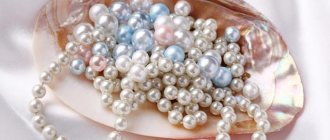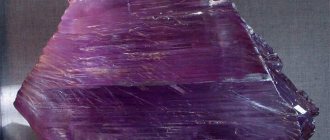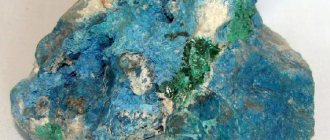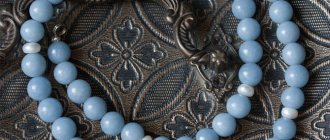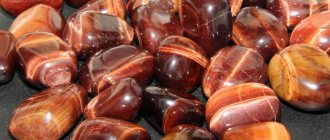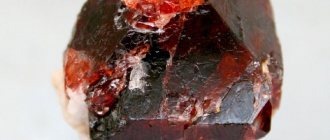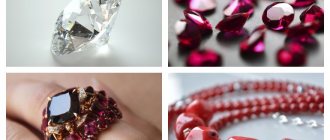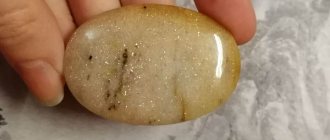A story about scientists and sailors
Pliny the Elder mentions tourmaline under the name “lychnida”.
Moreover, the scientist distinguishes between varieties of the mineral:
“one that sparkles with purple, the other that is a scale, heated by the sun or the friction of the fingers, they attract chaff and fibers of paper.”
Biruni does not write about tourmaline as an independent mineral.
In an Armenian manuscript from the 18th century. the stone “tirmil” is mentioned - red-green in color.
Red tourmalines in Russia were used to decorate church utensils.
Gems came to Europe from Ceylon. Dutch sailors, who transported cargo from Ceylon to Europe, noticed the beneficial properties of pebbles. They attracted ashes. Those who like to smoke a pipe cleaned their “nose warmers” with the help of gems. And they even gave the stone its name. "Aschentrekker" - " pulling ashes ."
origin of name
Tourmaline - Turmalin - Tourmaline.
From Sinhalese " turmali ". Group name for gems brought from Ceylon (Sri Lanka).
Expert opinion
Semenishcheva Polina
Specialist in mineralogy. Graduated from St. Petersburg Mining University.
Interesting : because of the pyroelectric effect, the crystals were called Ceylon or ash magnets.
- In Germany, Aschenstein (ash stone) and Aschenbrocken (ash crusher).
- In the 18th century green tourmaline, just introduced to Europe, was commonly called Brazilian emerald, and blue tourmaline, Brazilian sapphire.
- “ Ceylon peridot ”, “ Ceylon peridot ” are honey-yellow tourmalines.
Expert opinion
Semenishcheva Polina
Specialist in mineralogy. Graduated from St. Petersburg Mining University.
But all “geographical” names are incorrect and should not be used.
Tourmaline colors
For tourmaline, there are about 50 known colors and shades in which it can be painted.
As a rule, each color has its own name and is considered a separate variety. Green tourmaline is considered a classic stone. Crimson and pink tourmalines are also widespread in nature; yellow and blue crystals are rare. Polychrome samples are also found that combine several shades at once. All of them can be either transparent or opaque. Often the color is distributed unevenly over the surface of the stone: its intensity changes from different viewing angles. There are specimens with the “cat’s eye” effect and with alexandrite.
These different, different, different stones
Tourmalines are distinguished by colors:
- Chameleonite. Has an alexandrite effect. It is olive green in daylight and brownish red in artificial light.
- Verdelite. Greens - from light spring greens to dark greens. The color is due to the presence of iron ions. The shades in the crystal change, smoothly shimmering.
- Indigolite. Blue of all shades. The name comes from indigo, a shade of blue. In Russia in the old days it was called baus.
- Dravit. Color ranges from pale cognac to rich brown. Named after the Austrian Dravet deposit.
- Schorl. From the old German miner's term schorl. Black, gloomy, opaque. It is in great demand among magicians and sorcerers.
- Sibirit. Purple-red stone. Found in Siberia, of course.
- Achroite. It got its name from a combination of Greek words; means "without color". Rare colorless variety.
- Liddicoatite. Relatively recently it was recognized as a separate variety of tourmaline. Geometric patterns can be amazingly beautiful.
Polychrome crystals are varied.
Some have a black or red top, called the "Moor's (Turk, Negro) head."
When cut, watermelon tourmaline can resemble a piece of watermelon, with a kelly rind and pink “pulp.” But there are also “stones in reverse” - the middle is green, surrounded by pink.
Watermelon tourmaline 3.6 carats
The healing properties of tourmaline
Tourmaline has a positive effect on the endocrine and nervous systems, helps in the treatment of cancer, and promotes healthy sleep.
The influence of tourmaline on certain organs and systems of the human body is also determined by the color of the mineral. Green stones are used in the treatment of diseases of the liver, kidneys, circulatory system, skin, nervous system, they strengthen the immune system. In addition, they are characterized by pronounced anti-aging properties. Blue tourmalines have a positive effect on hormonal levels, the state of the lymphatic and immune systems. Black tourmalines have protective properties and protect a person from various negative influences. They remove negative energy and cleanse the body as a whole. Multi-colored samples of tourmaline help achieve harmony and normalize the functioning of the body.
The most commonly used stones in lithotherapy are pink, green, black and blue tourmalines.
Properties
Complex boron-containing silicate of magnesium and aluminum.
An oblique view of the whole crystal structure of tourmaline
View of a tourmaline structure unit along the crystal axis
Axis view of three columns of tourmaline units forming a bundle
Structure of a tourmaline crystal as viewed along the c-axis of the crystal
Physico-chemical
- The crystals are hard but brittle.
- Tourmaline that changes color when daylight changes to artificial light is called chameleonite.
- The crystals have a well-defined zonal growth pattern. The color change occurs not only along the main axis of the crystal, but also in the transverse direction.
- Dichroic; This is especially evident in the “head of a Negro (Moor, Turk)” variety.
- It has a piezoelectric effect (when pressed or mechanically applied, an electric charge appears on the surface of the crystal).
- Has pyroelectric properties.
- Mineral crystals are sensitive to temperature increases. If you electrify a crystal, its temperature changes. Tourmaline directly converts thermal energy into electrical energy.
- The red color of the gems is stable when heated.
- Red tourmaline has a strong pleochroism - from dark red to yellow to scarlet.
Tourmaline pleochroism
Some crystals have a sharply defined thin strip of light, if possible oriented along the long axis of the polished stone. This is a cat's eye, highly prized by mineral connoisseurs.
Lithotherapist's book
First, visit a doctor, find out the diagnosis, buy medicine... And only then, if you want, start treatment with stones.
- Lithotherapists in the USA use sherls to get rid of negative energy and relieve pain. To do this, the “pendulum” with the crystal is rotated counterclockwise over the sore spot.
- Verdelite is used in lithotherapy as a strengthening nervous system and rejuvenating agent. Helps with heart and kidney diseases.
- Indigolite harmonizes the hormonal system and stimulates metabolic processes in the body.
- Rubellites normalize blood composition and improve heart function.
- Dravit is used for insomnia, stress, and depression.
Important : thyroid disease, fever (high temperature), pacemakers, pregnancy - the use of tourmaline is not recommended for these conditions.
Colorful magic
Each variety has its own magic.
| Variety | Magic properties |
| Indigolite | Used by magicians and astrologers to connect with the energy of the Cosmos |
| Achroite | Clears the mind, creates a balance of physical and spiritual forces |
| Rubellite | Harmonizes the heart chakra |
| Dravit | Stimulates Manipura Chakra |
| Verdelite | Restores the integrity of the aura. |
| Cherry red tourmaline | Associated with tantric energies |
- Rubellites “manage” love and similar emotions.
- Indigolite is a good talisman for students.
- Verdelites are useful for creative people.
- Achroites are good for yoga fans. These stones are suitable for meditation.
Expert opinion
Semenishcheva Polina
Specialist in mineralogy. Graduated from St. Petersburg Mining University.
Each type of gem will protect the owner from negative energy.
Magical properties of the mineral
Studying the magical properties, it becomes clear that a mineral can bring benefit and harm to its owner, it all depends on how a person uses the energy of the stone.
The main magical feature of the crystal is its ability to create a powerful protective field around the owner. The power of the stone quickly neutralizes physical negativity, expressed in radiation from:
- TV;
- microwave;
- computer.
It is enough to simply place a precious talisman next to this device.
The main magical effect, of course, is determined by the color of tourmaline:
- Green will help you believe in your own strength and teach a person to see a way out even in the most hopeless situation.
- Red will attract the attention of the opposite sex to the owner.
- Pink is suitable for women. It helps to calm down and stop self-searching, which does not help in moments of crisis, but only aggravates the situation.
- Watermelon will make the owner softer, more forgiving, help you find love, and increase libido.
- Raspberry will be an assistant for creative people.
- Lilac will help control emotions, which is important for many.
- Blue is a wonderful talisman for those who protect family values. His power will protect the house, helping to turn it into a real nest.
- Paraiba is perfect for those who strive for inner harmony and want to get away from depression.
- Achroite will help fight emotions and stabilize the emotional state.
- Blue will help with spiritual quests and self-discovery, and is great for scientists.
- Brown will physically and mentally strengthen its owner. A bracelet with such a stone will help protect against negativity and envy. This is an effective amulet for older people.
- Black creates a strong protective ring around its owner, helps people who are often jealous, envious, and hate others to get rid of such negative feelings.
With shimmering different shades, the stone is suitable for open, inquisitive people. The talisman will help you develop in your chosen direction and find something new for yourself every day. It is important to remember that natural, not synthetic stone has all these properties.
Areas of application
The unique property of a crystal to carry an electric charge is used in radio engineering.
Tourmalines are very popular among collectors.
The ability of crystals to carry an electrical charge is widely used by Western and Eastern manufacturers. And my God, where they don’t “insert” tourmaline. This:
- belts and bandages (on the knees, on the neck, on the lower back);
- bed sheets;
- socks and underwear;
- massage mats;
- dishes;
- bath balls;
- hair combs.
Jewelry beauty
And here is a little about jewelry art.
At the beginning of the 14th century. Jewelry art is developing in Europe, the masterpiece of which was the “Crown of Charles IV”, converted in 1346 from the crown of St. Wenceslas, the enlightener of the Czech Republic. It is decorated with unique polished stones: pink tourmaline weighing 250 carats; 2 Ceylon sapphires weighing 330 and 280 carats. and 17 sapphire cabochons weighing from 200 carats; 45 red Badakhshan spinels, the largest of which weighs 100 carats; 26 emeralds from Egypt, 20 pearls and an aquamarine.
A huge (over 100 grams in weight) pink tourmaline was purchased in Beijing. Of course, it went to the first lady of Russia, Catherine I. The gem adorned the empress’s crown. When she was replaced on the throne by Anna Ioannovna, the stone from Catherine’s crown was taken out and inserted into the crowns of the new empress. New broom, whatever you want...
The leaders of the Russian Orthodox Church respected the gem. The tabernacle with a large pink crystal (it belonged to the Annunciation Cathedral of the Kremlin) is now kept in the Armory Chamber.
A red stone the size of a pigeon's egg, which King Gustav of Sweden gave to Empress Catherine II in 1777. It was believed to be a ruby. However, research has shown that it is a pink tourmaline weighing 250 carats. Currently located in the Diamond Fund in Moscow.
Who is it suitable for?
- Actors.
- Pupils and students.
- To inventors.
Expert opinion
Semenishcheva Polina
Specialist in mineralogy. Graduated from St. Petersburg Mining University.
Attention : Sherls help you lose excess weight. However, lithotherapists do not recommend wearing them.
Zodiac signs
Tourmaline is suitable for many zodiac signs. The main thing is to choose the right variety.
Sherls are astrologically suitable for Gemini in the second decade.
Green and red gems are suitable for Sagittarius of the second decade.
Watermelon tourmaline is ideal for Aquarius of the 1st decade.
Other representatives of the star circle can wear tourmaline jewelry without harm and be treated with the gem.
Is Tourmaline right for you?
Not really
Element
All elements (Earth, Water, Air, Fire). Depends on the type of gem.
Planets
Pluto
Venus
Energy
Depends on the variety. Either Yang or Yin. In polychromes both types of energies are present.
Tourmaline and zodiac sign
Astrologers recommend tourmaline to various zodiac signs depending on the color of the stone. Pink and green tourmalines are suitable for Aries, Leo and Libra; they bring calmness to the owners, smooth out hot temper and stubbornness, and help in finding harmony. Sagittarius and Aquarius are combined with blue stones, which develop in them conscientiousness, love of truth, calmness and getting rid of excessive expression of emotions. Black tourmaline is best for Scorpios. It has a positive effect on the nervous system, helps eliminate irritability and cope with stress.
Variegated mix
Astrologer Nazarova writes that tourmaline belongs to the group of warrior stones (together with fluorite, pyrite, spinel).
All the beauty of tourmalines is most clearly revealed in daylight. Artificial and evening light extinguishes the beauty and shine of tourmaline.
The most valuable type of mineral is Paraiba Tourmaline.
While searching for mica in the state of Minas Gerais (Brazil), tourmaline deposits were discovered. You don't always find what you're looking for.
The color intensity of tourmalines is valued only up to a certain optimal limit. Above this limit their value decreases.
The famous astrologer T. Macia advises decorating with sherlom rooms where it is necessary to limit excessive frivolity and sensuality.
According to G. Smith, red tourmaline, having been exposed to daylight for about a hundred years, noticeably turns yellow.
The Indians believed that watermelon tourmalines enhance a person's sexual abilities and kindle the passion of love. Therefore, men wore these stones with pleasure. But watermelon tourmaline was prohibited for women. A woman's love will create problems for her man...
Questions/Answers
There are quite a lot of tourmalines. This article is a review, “about everyone in general.” But if you have questions, ask them.
How to distinguish a fake?
- Examine the stone with a magnifying glass. A real gem has shimmers and halftones. The fakes don't have this.
- Look for inclusions in the stone? A perfectly clean stone is most likely the work of human hands.
- Natural tourmaline is difficult to scratch. This is not glass.
- Rub the stone with a woolen cloth. Real tourmaline will attract hairs, tiny pieces of paper, and dust.
Please note: “watermelon” tourmalines are often made from cutting crystals of different colors.
In the 1920s, bluish tourmalines from Namibia entered the market. There was demand for green stones. Therefore, Namibian gems were heated, which changed their color to green.
Important : sometimes crystals are refined by annealing or irradiation. Such stones are not considered fake.
How to care?
- Tourmalines are micro-vacuum cleaners. Therefore, store your jewelry in a tightly closed case.
- If a pebble gets dirty, wash it in soapy water and rinse with clean water. Dry with a napkin. Try not to rub the stone. Otherwise, the piezo or pyroelectric effect will work, and your stone will find dust, like an exemplary housewife.
- Gems do not like bright sun - they can fade. But even in the evening, under artificial light, tourmaline loses some of its shine and color.
- Protect your jewelry from aggressive liquids and household chemicals.
How to wear?
- The gem will accept gold and silver equally well. Tourmaline will not accept simple frames (jewelry alloys, copper).
- The stone is rarely set in platinum.
- The magical properties of tourmaline are more pronounced in combination with silver.
- In the old days, tourmalines were recommended to be worn on the index finger of the right hand or on the middle finger of the left hand. Moreover, the frame should be gold or silver.
What is the price?
- A good option is to buy individual cut gems and give them to a jeweler to create a custom piece of jewelry.
- The differences between tourmaline varieties can be significant. Prices per carat of Paraiba start from $4000-6000. Connoisseurs will not be surprised by the price of $20,000 per carat.
- “Simple” tourmalines start at $20 per carat.
- But we must take into account that the price greatly depends on the variety.
- Weight, purity, color, variety affect the final cost of jewelry. And of course, add the cost of the frame here.
What colors are there?
The colors of the stone depend on the presence of iron, chromium, and manganese ions.
Red, green, blue, black, tan and simply colorless.
There are more than fifty shades of tourmaline.
The most valuable ones are pink and red.
In second place are green ones, their color approaches emerald.
Polychrome types are good. One crystal can have up to five colors.
Where can I buy?
Large online stores, jewelry stores, exhibitions and sales of stones. Expensive varieties (for example, Paraiba) should be purchased where they will provide you with proof of the authenticity of the stone.
What stones does it go with?
For the most part, tourmalines are “selfish”. Their energy is self-sufficient; it can hardly tolerate the proximity of other gems.
Tourmaline especially conflicts with rubies, sapphires, and alexandrites.
For your information : P. Globa reports that tourmaline is “not friendly” with garnets.
